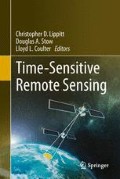Abstract
Remote sensing can provide useful information in post-disaster assessments, depending on the type of hazard and when in the emergency response and recovery stage, the particular types of information are required. Three general types of post-disaster assessment can be defined, for which remote sensing may contribute to data gathering and information delivery: (1) large-area reconnaissance, situational awareness, and/or mapping of damage extent and severity (i.e., what communities suffered the most impact), (2) impact to family stability in terms of homes and businesses damaged or destroyed, and (3) impact to critical infrastructure such as roads, energy grids (electrical, gas and water), and public facilities.
This chapter provides a comprehensive perspective on the rationale and end-to-end design of time-sensitive remote sensing systems (TSRSS) that are able to provide timely information on magnitude and extent of damage immediately following hazard events in support of emergency management decision-making. An emphasis is placed on airborne platforms because of their greater flexibility and lower altitude of operation, which enables finer spatial resolution sensing and greater control over imaging characteristics, as well as improved temporal tasking.
Remote sensing and related technologies associated with small aircraft, consumer grade digital cameras, and image processing procedures have matured substantially over the past decade and have been integrated into prototype TSRSS that are ready for operational and cost effective implementation for post-hazard damage assessment. Although some technology development in the area of image analysis still remains to be accomplished, the main limitations to implementation are institutional in nature (e.g., funding, technology coordination and acceptance, and government regulations). These limitations are worth overcoming so that TSRSS are implemented to save lives, aid in recovery, rehabilitation and remediation, and reduce clean-up costs associated with disasters.
Access this chapter
Tax calculation will be finalised at checkout
Purchases are for personal use only
References
Alexander D (2002) Principles of emergency planning and management. Oxford University Press, New York
Ambrosia VG, Wegener SS, Sullivan DV et al (2003) Demonstrating UAV-acquired real-time thermal data over fires. Photogramm Eng Remote Sens 69:391–402
Coulter L, Stow D (2008) Assessment of the spatial co-registration of multitemporal imagery from large format digital cameras in the context of detailed change detection. Sensors 8:2161–2173
Coulter L, Stow D, Baer S (2003) A frame center matching approach to registration of high resolution airborne frame imagery. IEEE Trans Geosci Remote Sens 41(11):2436–2444
Coulter L, Stow D, Lippitt, C, Dua S, Loveless B, Chavis C, Kumar S (2013) Rapid, high spatial resolution image assessment of post-earthquake damage. Final report to the Department of Homeland Security for a project conducted by San Diego State University and the Naval Postgraduate School, March 2013
Cutter SL (2003) GI Science, disasters, and emergency management. Trans GIS 7:439–446
Du Q, Raksuntorn N, Orduyilmaz A et al (2008) Automatic registration and mosaicking for airborne multispectral image sequences. Photogramm Eng Remote Sens 74(2):169–181
Hodgson ME, Davis BA (1998) Remote sensing and GIS for hazards—foreword. Photogramm Eng Remote Sens 64:976–976
Hodgson ME, Davis BA, Cheng Y et al (2010) Modeling remote sensing satellite collection opportunity likelihood for hurricane disaster response. Cartogr Geog Info Sci 37(1):7–15
Joyce KE, Belliss SE, Samsonov SV et al (2009) A review of the status of satellite remote sensing and image processing techniques for mapping natural hazards and disasters. Prog Phys Geogr 33:183–207
Laliberte AS, Herrick, JE, Rango A et al (2010) Acquisition, orthorectification, and object-based classification of unmanned aerial vehicle (UAV) imagery for rangeland monitoring. Photogramm Eng Remote Sens 76(6):661–672
Lippitt CD, Stow DA, Clarke K (2014) On the utility of models for time-sensitive remote sensing. Int J Remote Sens 35:6815–6841
Phinn SR (1998) A framework for selecting appropriate remotely sensed data dimensions for environmental monitoring and management. Int J Remote Sens 19:3457–3463
Stow D, Coulter L, Baer S (2003) A frame centre matching approach to registration for change detection with fine spatial resolution multi-temporal imagery. Int J Remote Sens 24:3873–3879
Stow D, Hamada Y, Coulter L et al (2008) Monitoring shrubland habitat changes through object-based change identification with airborne multi-spectral imagery. Remote Sens Environ 112:1051–1061
Stryker T, Jones B (2009) Disaster response and the International Charter Program. Photogramm Eng Remote Sens 75:1242–1344
Tralli DM, Blom RG, Zlotnicki V et al (2005) Satellite remote sensing of earthquake, volcano, flood, landslide and coastal inundation hazards. ISPRS J Photogramm Remote Sens 59:185–198
Visser SJ, Dawood AS (2004) Real-time natural disasters detection and monitoring from smart earth observation satellite. J Aerosp Eng 17:10–19
Wyawahare MV, Patil PM, Abhyankar HK (2009) Image registration techniques: an overview. Int J Signal Process Image Process Pattern Recognit 2(3):11–28
Zhang Y, Xiong J, Hao L (2011) Photogrammetric processing of low-altitude images acquired by unpiloted aerial vehicles. Photogramm Record 26(134):190–211
Zitova B, Flusser J (2003) Image registration methods: a survey. Image Vision Computing 21:977–1000
Acknowledgements
The work was partially funded by the U.S. Department of Homeland Security and the Naval Postgraduate School at Monterey (Award Number G00009228) and by the National Science Foundation Directorate of Engineering, Infrastructure Management and Extreme Events (IMEE) program (Grant Number G00010529).
Author information
Authors and Affiliations
Corresponding author
Editor information
Editors and Affiliations
Rights and permissions
Copyright information
© 2015 Springer Science+Business Media New York
About this chapter
Cite this chapter
Stow, D., Lippitt, C., Coulter, L., Davis, B. (2015). Time-Sensitive Remote Sensing Systems for Post-Hazard Damage Assessment. In: Lippitt, C., Stow, D., Coulter, L. (eds) Time-Sensitive Remote Sensing. Springer, New York, NY. https://doi.org/10.1007/978-1-4939-2602-2_2
Download citation
DOI: https://doi.org/10.1007/978-1-4939-2602-2_2
Published:
Publisher Name: Springer, New York, NY
Print ISBN: 978-1-4939-2601-5
Online ISBN: 978-1-4939-2602-2
eBook Packages: Earth and Environmental ScienceEarth and Environmental Science (R0)

